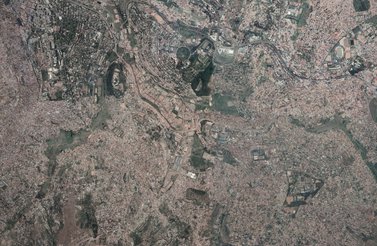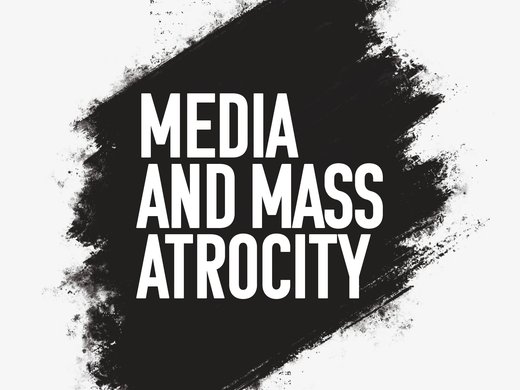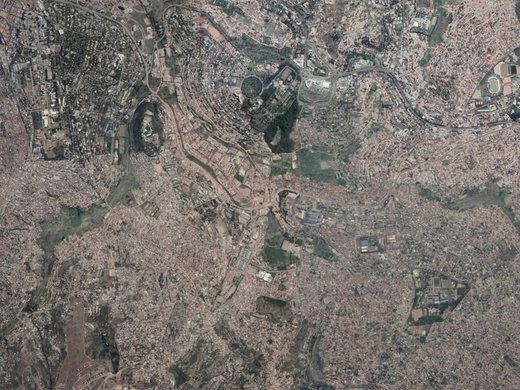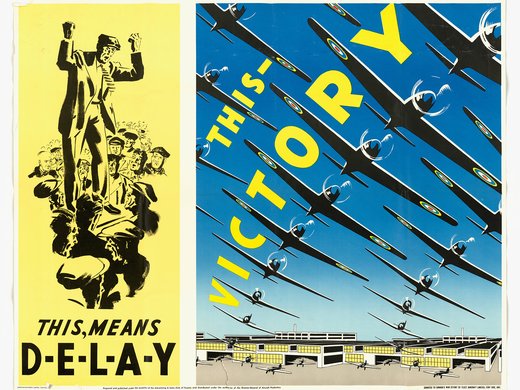Two grainy videos captured nearly a quarter century apart show us the brutal deaths of the innocent. The first video was shot in the early days of the 1994 Rwanda genocide, and the second in northern Cameroon during counter-insurgency operations against Boko Haram in 2015. Both videos are important records of those events in and of themselves, but the murders captured on camera — and the way we came to learn about them — tell us much more about the perplexing terrain where the media and mass atrocity intersect.
The video from Rwanda shows us two figures kneeling in the dirt of a Kigali street, their arms outstretched to the death squad members who, moments later, would brutally beat them to death with clubs. The footage was taken by British cameraman Nick Hughes on April 11, 1994, and it tells the story of the final moments of two of the genocide’s early victims, murdered before the unflinching eye of the camera.
Within hours, CNN broadcast the recording, and other major outlets quickly followed suit. The crime of genocide appeared on television screens globally, although most people viewing it didn’t fully understand what they were looking at. The footage marked one of the few instances of a journalist recording a killing during a bloodbath that claimed hundreds of thousands of lives, and its rarity spoke to the world’s indifference to the atrocities in Rwanda.
The footage by Hughes was another episode in the centuries-old connection between conflict and those witnessing it.
The footage by Hughes was another episode in the centuries-old connection between conflict and those witnessing it. For as long as people have been inflicting harm — and, at their worst, committing mass atrocities — someone has been there to observe what happened and relay that information to others.
Centuries before the evolution of modern-day journalism and media, scribes and participants in conflict recorded or reconstructed horrific scenes of human atrocity. In 401 BC, the Greek writer and mercenary Xenophon led his soldiers in an epic retreat and described the fearsome enemies who decapitated their foes and gleefully carried the dismembered heads as trophies. In his account of the siege of Jerusalem in AD 70, the Jewish historian Josephus wrote of a baby being cooked and eaten. In the early 1800s, the artist Francisco de Goya used lithographs — one of the first image-reproduction technologies — to illustrate the savagery of the Napoleonic suppression of a Spanish uprising.
As modern journalism evolved in the last few centuries and the role of the professional war correspondent developed, coverage of conflict and mass atrocity came to be regarded as one of journalism’s most important pursuits. Journalism has long been a critical pillar of good governance; it informs policy makers and citizens alike about events unfolding elsewhere in the world, and shapes our view about how to best respond.
The Footage from Rwanda
When human beings are at their worst — as they most certainly were in the tiny central African country of Rwanda during the 1994 genocide — the institutions of journalism and the media must be at their best. Sadly, for a whole host of reasons, the media fell short in Rwanda.
While the killings happened in broad daylight, the atrocities underway in Rwanda 25 years ago didn’t fully penetrate public consciousness. Confronted by Rwanda’s horrors, international news media often turned away, or muddled the story when they did pay attention; killings were often covered as if they were part of anarchic tribal warfare rather than an organized genocide. Further, international media overlooked the war crimes that the Rwandan Patriotic Front (RPF) committed during the genocide and in its aftermath, leaving the world with a skewed narrative. The RPF is still Rwanda’s ruling party.
Local media contributed to the problem as well. Hate propaganda media outlets in Rwanda played a role in laying the groundwork for genocide, and then encouraged the extermination campaign. Months before the killings erupted, the magazine Kangura and private radio station RTLM engaged in a relentless campaign to vilify and demonize the Tutsi in Rwanda as untrustworthy allies of the RPF rebels and as a threat to Rwanda’s Hutu majority population.
International media failed to grasp what was unfolding in Rwanda. Arguably, Hughes’s shocking footage carries such weight today in part because of the faulty picture that media painted of 1994 Rwanda; the video stands in contrast to the superficial or simply non-existent coverage of the genocide. It would be 15 years before the full story of what was happening in the Hughes footage would be told.
Here’s how I told that story for The Toronto Star in 2009:
The footage was taken on April 11 — just five days after the assassination of President Juvénal Habyarimana — from the top floor of a building known locally as the French school. One of only a handful of Western journalists in Rwanda, Hughes, a freelance camera operator, heard earlier in the day about killings taking place in the Kigali neighbourhood of Gikondo, a stronghold of Hutu extremists.
Earlier, on his way up the steps of the French school, Hughes met Reuters cameraman Mohammed Shaffi, who told him that from above he could see killers slaughtering people, across the valley. On a top floor, Hughes encountered a Belgian paratrooper. The distraught soldier was looking through the scope of a weapon and pointed to the dirt road across the valley. Hamstrung by a United Nations mandate forbidding outright intervention, the paratrooper had been watching death squads drag people out of their homes to be tortured and killed in broad daylight, their bodies then left in a heap in the clay.
It was just after 10:00 a.m. when Hughes set up his camera. He first focuses on some of the bodies strewn along the road, then pans across the valley and through the trees. When he pans back, he spots a cowering woman and a praying man who have apparently been hauled up from the side of the road and are now among the pile of bodies. Kneeling in the red clay, the man repeats the same motion over and over, clasping his hands in front of him, then spreading his arms wide, palms turned upward. A throng of men mills about nearby, holding machetes, crowbars and sticks with nails protruding from them. Hughes watches for about 20 minutes, periodically turning off his camera because he knows that he is almost out of tape and fears his batteries are running low. He also knows what is coming, and the journalist in him wants to capture the moment.
As if resigned to his fate, the praying man turns heavenward, still praying as two men approach the scene on the street. One, dressed in dark trousers and a white shirt, winds up to strike the praying man. The attacker has the posture of someone about to whip an animal. The victim recoils before he is struck on the head with a stick. The praying man crumples to the ground, then suffers more blows from his murderer. Moments later, the woman is struck down by another assailant, who swings with such force that her head is very nearly lopped off by the initial blow. Finally, the two killers walk away casually, leaving the bodies.
The Rwanda genocide would claim hundreds of thousands of lives, but remarkably, this is one of the few times a killing was caught on video by the media.
Eventually, during visits to Rwanda, I managed to identify the man and the woman who had been killed on the road that day. A Rwandan filmmaker and I found eyewitnesses to the killings Hughes had recorded, two women who lived on either side of the road. They had watched in horror as their neighbours were killed and, all those years later, spoke their names: Gabriel Kagaba and his daughter, Justine Mukangango. I had a chance to meet with Rosalie Uzamukunda, Kagaba’s wife, who survived that day. She was unaware of the famous footage that chronicled the dying moments of her husband and daughter but insisted on watching the footage. Then — in one of the most powerful experiences of my two decades reporting — Uzamukunda shared with me stories and photographs of Gabriel and Justine, transforming them from the nameless statistics that were so common in media coverage of the Rwanda genocide.
While media didn’t capture our attention in 1994, the images recorded by Hughes have since then effectively functioned as defining footage of the genocide, much like Abraham Zapruder’s 486 frames of the Kennedy assassination. The pictures of those men wielding clubs and hacking their victims are used over and over in documentary accounts. The footage was even fictionalized in the film Hotel Rwanda, in which a cameraman played by Joaquin Phoenix rushes to show his producer the video of a killing he has just captured in the streets of Kigali. In the Hollywood version, no one really cares; the heroic Rwandan hotel manager played by Don Cheadle asks, “How can they not intervene, when they witness such atrocities?” Phoenix’s character responds: “If people see this footage, they'll say, ‘Oh, my God, that's horrible’ and then go on eating their dinners.” And that’s exactly what happened. Rwanda never became a cause célèbre. And the killing in Gikondo rolled out across the country for another three months.
Hughes captured what should have been, in its day, one of the iconic media images of the Rwanda tragedy. The footage is akin to the 1972 photo of a terrified little girl running from a napalm strike during the Vietnam War, or the image of the solitary figure in front of an advancing tank in Tiananmen Square in 1989, or the pictures of the falling man plummeting to his death after leaping from the World Trade Center on September 11, 2001. These images transcended historical events. But the images of the praying man and the woman who perished beside him on a dirt road in Rwanda are different — they signalled what was still to come.
The footage captured in Rwanda depicted the first moments of a genocide that would overtake Rwanda. Perhaps more informed and comprehensive media coverage might have fostered some kind of groundswell in support of intervention. And perhaps, if people had better understood the political climate in Rwanda or the scope of the genocide, it would not have been so easy for US President Bill Clinton’s administration to lobby against intervention.
The Footage from Cameroon
More than two decades after the genocide in Rwanda, another video of the execution of innocents entered the public sphere, this time on YouTube — one of many social media platforms that didn’t exist during the Rwanda events.
The video shows two women being forced down a dirt path by men in military fatigues. One of the women is being dragged by a man with an automatic rifle slung over his shoulder; a little girl holds her hand and walks alongside. Other soldiers follow with a second woman prisoner; an infant is strapped to her back. One of the men can be heard accusing the women of belonging to the jihadist group Boko Haram and saying, “You’re going to die.”
The man with the camera can be heard calling some of the soldiers by name, cheering them on.
In the final scene, the women, who remain silent throughout, are blindfolded and forced to the ground, along with the children. The little girl has her T-shirt pulled over her head. The baby stares blankly at the camera. All four are executed, shot at close range a total of 22 times.
Now, we know the video was captured between March 20 and April 5, 2015, just outside a village called Krawa Mafa in northern Cameroon. This atrocity occurred less than a kilometre from the town of Zelevet on Cameroon’s border with Nigeria. The video was most likely shared on private networks such as WhatsApp before it surfaced on Facebook and Twitter on July 10, 2018. It immediately went viral on social media.
Within hours, the video captured the attention of professional journalists and news organizations, but also of a legion of self-described “open-source investigators” who use online tools to attempt to geo-locate events captured on video, to debunk myths or to hold perpetrators to account.
The British Broadcasting Corporation (BBC) and a collection of open-source investigators took particular interest in the video. Although they never met in person while conducting their investigation, never travelled to Africa and communicated almost exclusively through a Twitter direct message group, they were able to identify where the video was taken and when the horrific killings occurred and to determine the names of several of the perpetrators.
The government of Cameroon claimed in late 2018 that the identified men were facing justice, after initially denying the video had been taken in their country at all.
The collaboration between the BBC and the open-source investigators resulted in an 11-minute documentary by the BBC’s Africa Eye unit called Anatomy of a Killing. It was posted to YouTube, the BBC website and in a Twitter thread on September 24, 2018, causing a sensation. The Africa Eye report plays excerpts from the footage from Cameroon — with the exception of the gruesome killings — and then meticulously takes the viewer step-by-step through the online investigation.
The result is a remarkable piece of journalism — and much of it, the work of non-journalists.
Open-source Investigation
Among the first in the group to watch the video after it went public on July 10, 2018, was Benjamin Strick, an Australian web developer who dabbled in open-source investigations as a hobby. In an interview, he described how he downloaded the video from Twitter in an MP4 format, slowed the speed using iMovie and captured screenshots of the surroundings and distinctive features to cross-reference on Google Earth.
Strick posted a Twitter thread with screenshots from the video — the outlines of buildings, a walking path, the mountain ridge in the background — and asked for help to crowdsource and solve the puzzle.
Little did Strick know that others were doing exactly the same thing, among them Aliaume Leroy, another specialist in open-source investigations, who had recently been hired by Africa Eye because of his focus on using social media and open-source information as verification tools.
The investigators would set out to confirm the exact location of the video, when the killings had occurred and, finally, who the perpetrators were. The identities of the victims were never confirmed.
Within days of the video going viral, Strick and others had identified the distinctive outline of the ridge seen in the background of the video. They began the quest to use Google Earth to match that ridge to an actual location in northern Cameroon and reached out online for help in narrowing down the search. One key tip came to Strick from a contact who sent him a direct message on Twitter, suggesting he narrow his search to the town of Zelevet, an area that had been seized by Boko Haram insurgents.
Narrowing their search to the Zelevet area, they eventually matched the path that the soldiers had marched their victims along. Confident that they knew where the video had been taken, the team set out to confirm the timing. Again, the video itself contained the clues. By identifying buildings that had come and gone and the presence in the video of a footpath that appears only during the dry season, investigators narrowed the time frame.
Because the video was shot on a sunny day, the soldiers walking in front of the women in one part of the video cast shadows on the ground, like moving sun dials. Through a series of complex calculations, assisted by an app called SunCalc, investigators further narrowed the time frame, concluding that the video had to have been taken between March 20 and April 5, 2015.
Once again, a human source intervened, someone who was familiar with the soldiers in question. This source could verify the identity of three men seen in the video, matching their names to their faces: Tchotcho Cyriaque Bityala; Barnabas Donossou; and Lance Corporal Tsanga, also referred to by the nickname Cobra.
Anatomy of a Killing, both the 11-minute YouTube documentary uploaded to the BBC website and the Twitter thread, went viral. The project’s impact on Twitter is fascinating; Daniel Adamson, the BBC producer who leads the Africa Eye team, told me that it generated 57,000 re-tweets, reaching an estimated 15 million Twitter users. The story, he said, was made for the basic structure of a Twitter thread, with each individual tweet containing a single finding, which, linked together, told a story. That format mirrored the structure of the investigation itself, a series of individual findings that became linked into a chain of evidence.
Adamson sees Anatomy of a Killing as one of the best examples of the kind of fusion of traditional journalism and the “magnificent accountability investigative work done by citizen journalists” that he hopes will provide a way forward for media.
Looking back, Leroy and Strick concede that the conventional journalism technique of using human sources — in this case, the anonymous sources who led investigators to Zelevet and also confirmed the identities of three of the perpetrators — proved to be a turning point. However, the result was a fusion of traditional journalism and open-source intelligence extracted by so-called “couch analysts.”
In the case of Rwanda, the media was accused of downplaying the story. For a variety of reasons, there just weren’t enough journalists on the ground to reach the kind of critical mass that would force the story into the public eye. After Anatomy of a Killing, it is difficult not to imagine how the story in Rwanda might have been different if millions of people on the ground had held mobile phones capable of capturing images and video and of connecting with a global network on Twitter, Facebook and Instagram in real time. Imagine what news organizations might have done with such streams of user-generated content. Imagine what legions of open-source investigators might have made of the publicly available satellite imagery of virtually every square inch of Rwanda, combined with videos posted by victims, survivors, witnesses and, indeed, the perpetrators themselves.
Where Media and Mass Atrocity Meet
Going forward, we no longer need to imagine — this world very much exists. However, news media is not without new challenges. Outlets have scaled back their foreign bureaus significantly. And media tools — from terrestrial broadcast to Twitter — are often used by the forces perpetrating many of today’s atrocities, sometimes to great effect.
Some see hope for new forms of collaboration among mainstream news organizations, citizen journalists and open-source investigators. Look, for example, at the war in Syria, a conflict that laid bare the coincidence of two unprecedented situations, the near absence of traditional media, and the emergence of social media and user-generated content to occupy the void.
With a few notable exceptions — because of security concerns and cost — international media were unable to put boots on the ground to cover Syria, in contrast to their presence during the war in Iraq a decade earlier. On the one hand, many incidents in the war in Syria unfolded beyond the range of television cameras. On the other, it was the first major conflict to be extensively documented by those caught up in it. The combatants, as well as the civilians, were carrying video cameras embedded in their mobile phones. While journalists’ accounts were largely absent, so-called user-generated content streamed out of Syria from mobile phones. News organizations struggled to piece together a clear picture of what was happening, based on that flow of content. There were probably more minutes of content recorded and posted during the Syrian conflict then there were minutes of real time.
Journalists and non-journalists alike have the capacity to document, investigate and broadcast atrocity to a greater extent than has ever been possible.
Journalism can now tap into the evidence of war crimes and human rights violations that is generated by people using mobile phones. While this vast, new body of evidence offers great potential for accountability, there is a certain arbitrariness to it all. Clearly, many atrocities are not recorded on mobile devices, and those that are raise an important question: are we entering a world where nothing can be believed unless there is a high-quality video of it on YouTube?
Twenty-five years after the world watched the grainy video that Nick Hughes captured of the first killings in the Rwanda genocide, we still grapple with understanding images of atrocity. While the footage from Cameroon also documents violence, the way that video was received and investigated points to a modern picture of the intersection where media and mass atrocity meet. There are, of course, new challenges — the near ubiquity of social media and smart devices has introduced a flood of unverified content and tools that can be abused by corrupt regimes. But the fusion of traditional journalism and open-source investigation provides great hope, too. Journalists and non-journalists alike have the capacity to document, investigate and broadcast atrocity to a greater extent than has ever been possible. Today, it seems far less likely that atrocity could go entirely unreported or ignored.



